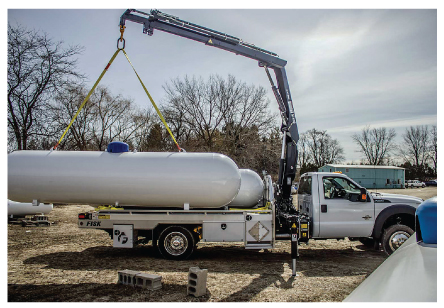Sunday, July 29, 2018
By Frank B. Thompson… The propane industry has just spent a lot of time and effort at Propane Days in Washington, D.C. to lobby Congress to exclude the cranes mounted on the beds of propane service trucks from costly certification. Perhaps my many years in the insurance business might give us another perspective to sway OSHA.

When I first started insuring propane companies 25-plus years ago, the tendency was to insure bobtails as two separate parts—the chassis and the tank. One of the questions on the application regarded the size of the tank. Over the course of time, we handled many claims questions from independent adjusters asking which part of the bobtail we intended to insure, the tank or chassis. The answer was both, as we had included the cost of the tank, meters, etc. in the “cost new” bracket on the application. The insurance industry’s commonsense answer then was to insure the entire unit.
Approximately 15 years ago, equipment manufacturers started adding small lifting devices to service trucks. The insurance industry wasn’t sure how to cover this new concept. This was a new device that stowed compactly, could be used to load a propane tank on the bed of a truck (doing away with a trailer), and could be used to unload and position the tank safely without causing injury to the employee.
The lifting devices were small, designed to lift a propane tank, and were not designed for the transportation industry, the construction industry, or the manufacturing industry. They are used exclusively to move and place propane tanks.
When these utility vehicles with the lifting devices called “cranes” were first introduced to the insurance industry, there was some pushback from the underwriters about how they were to be used. This pushback required explanation and, in some cases, field trips and videos were provided before the insurance underwriters decided to insure the utility or service vehicles including the “cranes,” air compressors, etc., as a unit. They insure the entire unit, and describe them as service vehicle w/crane or more commonly boom trucks, the same approach they used with bobtails.
The result of not classifying service trucks with their small lifting devices as cranes resulted in substantial insurance savings to propane marketers. If they were classified as cranes, each vehicle would need to have “boom coverage” and “on hook coverage.”
Large cranes need insurance in case of damage to the boom itself, and coverage is required for damage to the items being lifted or moved. Both of these coverages are paper-intensive and expensive, and not necessary for propane service vehicles w/crane.
The insurance industry, in conjunction with the propane industry, has pioneered a commonsense approach to how to move and position propane tanks. The service truck-mounted crane has increased productivity, improved safety for the worker, and provided cost savings for the consumer.
When the insurance industry’s position on how it insures and classifies boom trucks used by the propane industry was explained to Sen. Jeff Flake’s staff by the Arizona Propane Gas Association delegation at Propane Days, it was received warmly and as a commonsense approach that could be used as ammunition to help overturn OSHA’s crane ruling.
In conclusion, the insurance industry has already partnered with the National Propane Gas Association (NPGA) to not classify a service vehicle with a lifting device (boom truck) as a crane, and this significant difference should be stressed in all of the efforts of NPGA in our fight with OSHA. Common sense and a partnership that is working with the insurance industry should put more teeth into our negotiations with OSHA.
Frank B. Thompson is a chartered property and casualty underwriter based in Phoenix. He is the owner of PT Risk Management, an independent insurance company specializing in writing propane and petroleum risk policies throughout the U.S.

When I first started insuring propane companies 25-plus years ago, the tendency was to insure bobtails as two separate parts—the chassis and the tank. One of the questions on the application regarded the size of the tank. Over the course of time, we handled many claims questions from independent adjusters asking which part of the bobtail we intended to insure, the tank or chassis. The answer was both, as we had included the cost of the tank, meters, etc. in the “cost new” bracket on the application. The insurance industry’s commonsense answer then was to insure the entire unit.
Approximately 15 years ago, equipment manufacturers started adding small lifting devices to service trucks. The insurance industry wasn’t sure how to cover this new concept. This was a new device that stowed compactly, could be used to load a propane tank on the bed of a truck (doing away with a trailer), and could be used to unload and position the tank safely without causing injury to the employee.
The lifting devices were small, designed to lift a propane tank, and were not designed for the transportation industry, the construction industry, or the manufacturing industry. They are used exclusively to move and place propane tanks.
When these utility vehicles with the lifting devices called “cranes” were first introduced to the insurance industry, there was some pushback from the underwriters about how they were to be used. This pushback required explanation and, in some cases, field trips and videos were provided before the insurance underwriters decided to insure the utility or service vehicles including the “cranes,” air compressors, etc., as a unit. They insure the entire unit, and describe them as service vehicle w/crane or more commonly boom trucks, the same approach they used with bobtails.
The result of not classifying service trucks with their small lifting devices as cranes resulted in substantial insurance savings to propane marketers. If they were classified as cranes, each vehicle would need to have “boom coverage” and “on hook coverage.”
Large cranes need insurance in case of damage to the boom itself, and coverage is required for damage to the items being lifted or moved. Both of these coverages are paper-intensive and expensive, and not necessary for propane service vehicles w/crane.
The insurance industry, in conjunction with the propane industry, has pioneered a commonsense approach to how to move and position propane tanks. The service truck-mounted crane has increased productivity, improved safety for the worker, and provided cost savings for the consumer.
When the insurance industry’s position on how it insures and classifies boom trucks used by the propane industry was explained to Sen. Jeff Flake’s staff by the Arizona Propane Gas Association delegation at Propane Days, it was received warmly and as a commonsense approach that could be used as ammunition to help overturn OSHA’s crane ruling.
In conclusion, the insurance industry has already partnered with the National Propane Gas Association (NPGA) to not classify a service vehicle with a lifting device (boom truck) as a crane, and this significant difference should be stressed in all of the efforts of NPGA in our fight with OSHA. Common sense and a partnership that is working with the insurance industry should put more teeth into our negotiations with OSHA.
Frank B. Thompson is a chartered property and casualty underwriter based in Phoenix. He is the owner of PT Risk Management, an independent insurance company specializing in writing propane and petroleum risk policies throughout the U.S.


